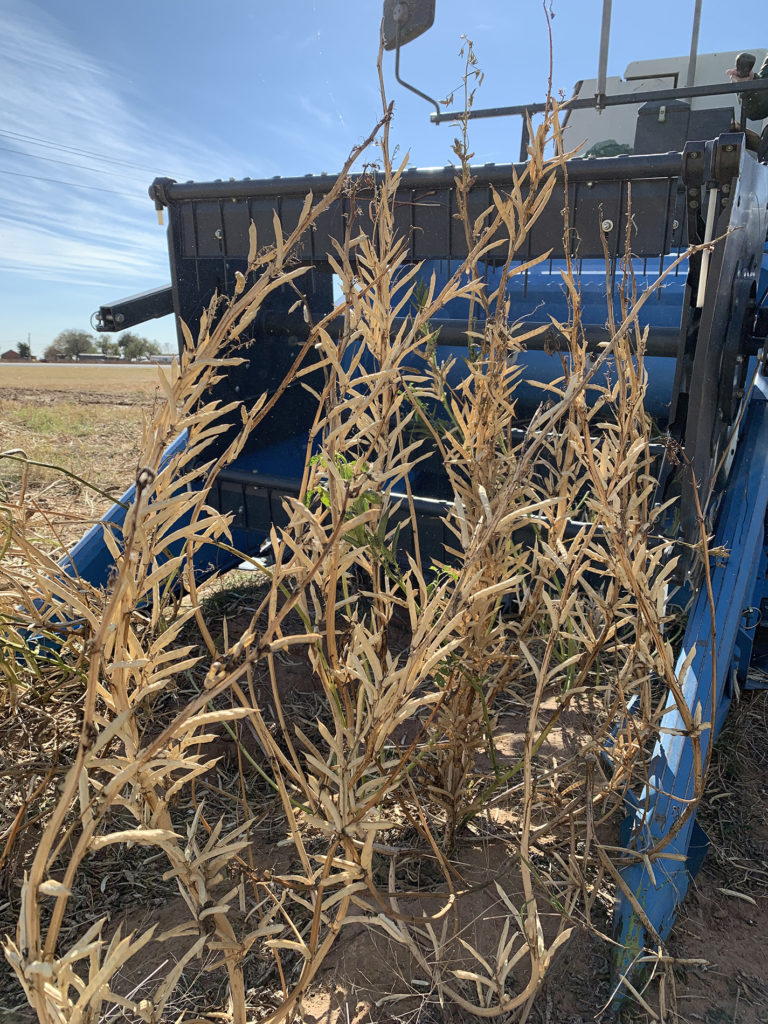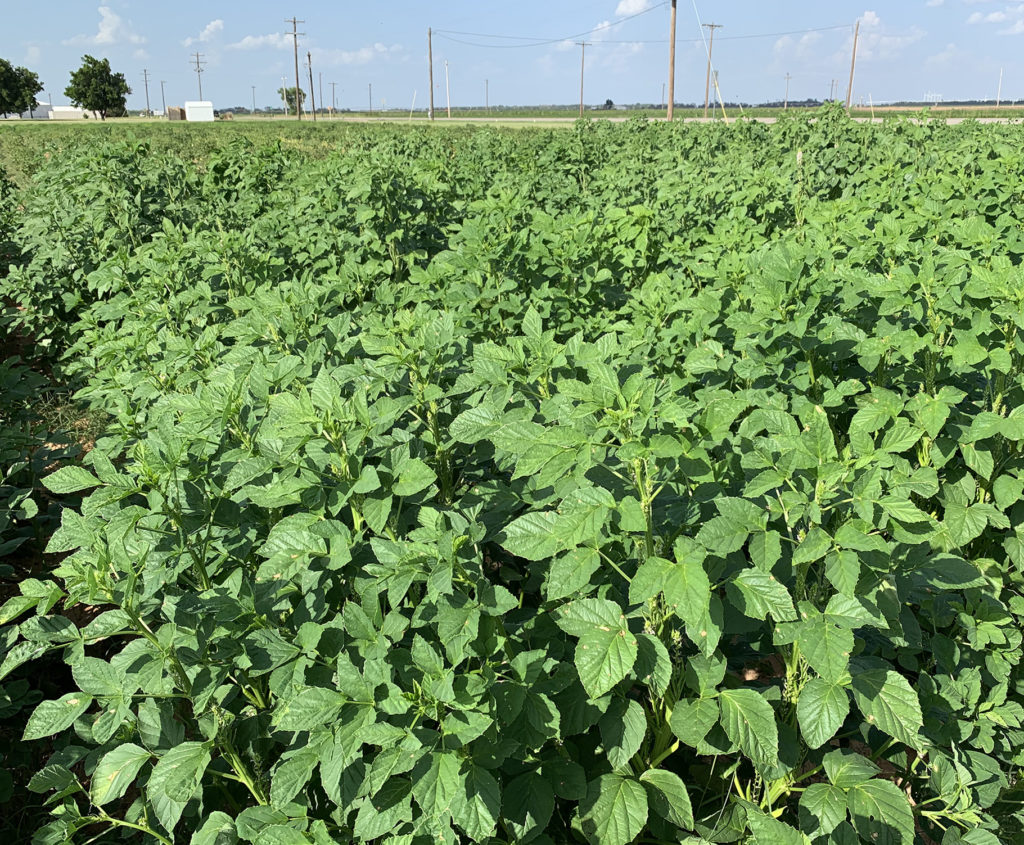Low-input, drought-tolerant guar crop could improve wheat production
AgriLife Research improving varieties suitable for Texas in preparation for return of guar market
In a season plagued by drought and high fertilizer prices, Texas A&M AgriLife scientists appreciate what guar provides in a crop rotation.
“Guar is a drought-tolerant, low-input crop that doesn’t require expensive fertilizers,” said Waltram Ravelombola, Ph.D., organic and specialty crop breeder at Texas A&M AgriLife Research and Extension Center -Vernon and Department of Soil and Crop Sciences. “We know guar improves soil health and increases the yield of the wheat that follows, making it a good rotational crop for producers to consider in the Southern Great Plains.”
Ravelombola is working on the final year of a project funded by a U.S. Department of Agriculture National Institute of Food and Agriculture grant, titled “Enhancing Ecosystem Services Through Integration of Guar into Wheat Cropping Systems of the Southern Great Plains.” The project started in 2018 and will finish up this year.
Guar is a legume, which means its roots can associate with Rhizobium bacteria in the soil to convert atmospheric nitrogen into fertilizer for the plant and soil. It’s adapted to the semi-arid conditions of Texas and is among the most drought-tolerant crop plants, with relatively low water use.
However, new research is needed to improve production and nitrogen-fixing qualities of the crop. Ravelombola said the guar varieties this project is working to improve were released 35 years ago or more.
“We want to provide farmers with more options to diversify their cropping systems,” he said. “For instance, with the fertilizer prices as high as they are now, if we had a variety that nodulates better, it could fix more atmospheric nitrogen and leave residual nitrogen for the following crop, thus reducing the requirement of synthetic fertilizer for the following season.”
Long-term and short-term goals of the research
The study’s long-term goal is to increase and stabilize guar production in the U.S. and increase the sustainability of wheat cropping systems in the Southern Great Plains region.
The immediate goal is to quantify wheat and guar crop development, productivity, nitrogen uptake and nodulation, and precipitation-use efficiency. Additionally, Ravelombola is studying the dynamics of soil nitrogen cycling and nitrogen-use efficiency, soil organic carbon storage and soil biological activity.
AgriLife Research is growing about 400 types of guar on approximately 8 acres in small plots. Two research plots are at Chillicothe, on 4 acres, and at Lockett, on 2 acres. His project also includes on-farm research on 1 acre with New Deal Grain Co. Another 1-acre plot is near Lubbock, grown in cooperation with Calvin Trostle, Ph.D., Texas A&M AgriLife Extension Service, Lubbock agronomist.
“Guar is a heat-tolerant, drought-tolerant crop,” Trostle said. “To the extent that climate change makes our climate warmer and drier and may influence Texas cropping, guar will perform relatively better compared to other crops we grow.”

He said older literature reports that dryland cotton yields are increased up to 15% after guar vs. in a cotton-cotton crop rotation, but more research is needed to evaluate this finding with modern varieties.
“Again, guar is a legume, and any time we can get a legume that grows well in a dry climate—and nodulates to fix nitrogen—this a potentially great benefit to farmers and cropping system stability,” Trostle said.
Guar is planted mid-May to July and harvested after the first freeze, which is used to defoliate the plants, typically in October or early November. Guar can be harvested using combines most grain producers already own.
In this final year of the grant-funded project, Ravelombola said he will work to improve the phenotyping of guar using technologies such as unmanned aerial vehicles, UAV, and 3D crop modeling. He also will investigate the genetic basis of nitrogen fixation in guar.
Maximizing nitrogen fixation of guar crop
Nitrogen fixation is the ability of the crop, in cooperation with soil-borne bacteria, to take in atmospheric nitrogen and thus reduce the need for commercial nitrogen fertilizers. The nitrogen from those legumes is a way to reduce the incorporation of synthetic nitrogen fertilizers.
“The major concern is that there is still a lot of research needed for the right inoculants for guar,” Ravelombola said.
A number of beneficial microorganisms, or inoculants, could be applied to the soil or the seed, but not all are optimal for guar.
“The existing inoculants are for soybeans, peanuts and cowpeas. Their efficiency for the fixation of nitrogen in guar is still questionable,” he said.
The ongoing testing of a wide range of existing inoculants will determine what can be adapted for guar, Ravelombola said. He said they hope to have that range narrowed down in another year or two.
“There could be different inoculants that work differently with the different cultivars,” he said. “We want to understand the genetic basis of the nitrogen fixation – the response to the addition of the inoculant based both on the inoculants and guar genotypes.”
Making the guar crop match the season
Another goal is to develop a short-season guar that will be harvested by September if planted in mid-June.
“A 90-day guar would be ideal for a crop rotation with wheat, especially if the wheat is grown for dual-purpose grazing and grain,” Ravelombola said.
The AgriLife Research program has breeding lines for the Texas environment, but he said he is also testing USDA Germplasm Resources Information Network lines to find any adapted to Texas conditions.
It could take as many as five years to develop a short-season variety, and he has only started evaluating those breeding lines last year. The process will repeat this year, and then the following three years will include advanced yield trials.
Marketplace exists, nearby processing doesn’t
While farmers have not been quick to adopt guar, Ravelombola hopes that will change when the research is finalized and disseminated to the producers.
“We know guar is an excellent rotational crop,” he said. “It can help diversify the cropping systems of farmers in the region. It’s also a profitable crop to grow.”
Trostle said this research is helping prepare for the day when favorable economics return for U.S.-grown guar.
Though guar is an annual $1 billion import market to the U.S., international production has been cheap since about 2014, making it difficult for U.S. farming and processing to compete, especially when other current crop prices like cotton, grain sorghum and sesame are at or near record highs.
However, when guar production resumes in the U.S., farmers may have a crop insurance option.
Trostle is currently working on a sub-contract with the USDA Risk Management Agency to develop guidelines for evaluating guar for crop damage and subsequent yield potential.
“This process started in 2018 with grower listening meetings in Brownfield and Vernon,” Trostle said. “Farmers in those meetings indicated that crop insurance would enable them to double acreage readily.”



